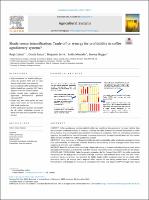| dc.description.abstract | This study assesses the economic viability of different coffee production strategies in Costa Rica and Guatemala, comparing intensive systems with shaded agroforestry approaches. Using a typology based on levels of intensification and sustainability, the authors applied a stochastic cash flow model based on ten years of farm-level survey data, including information on costs, prices, and yields.
Results indicate that high-productivity systems—with significant investment and moderate shade levels—achieve the highest Net Present Value (NPV) under future coffee price scenarios. Among low-investment systems, those with high shade cover yield a higher (and positive) NPV than low-shade systems, which on average produce negative returns despite similar investment levels. Diversification, particularly with high-value export avocados, marginally improves NPV, while other forms of diversification have limited economic impact.
Although high-productivity systems incur greater production costs, they generally offer higher probabilities of achieving positive net income and living wages, except in cases of severe price drops (e.g., a 50% decline in coffee prices). Conversely, a 50% increase in coffee prices would be necessary for all farmers to achieve positive net cash income and, in the case of intensive systems, approach a living wage threshold.
The study concludes that high-investment, high-productivity coffee systems are compatible with shaded agroforestry and are more likely to ensure economic success under most market conditions. For farmers with limited capacity to invest, high-shade systems offer more stable and positive returns across a wider range of price scenarios than low-shade alternatives. | es_ES |


